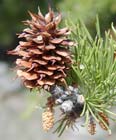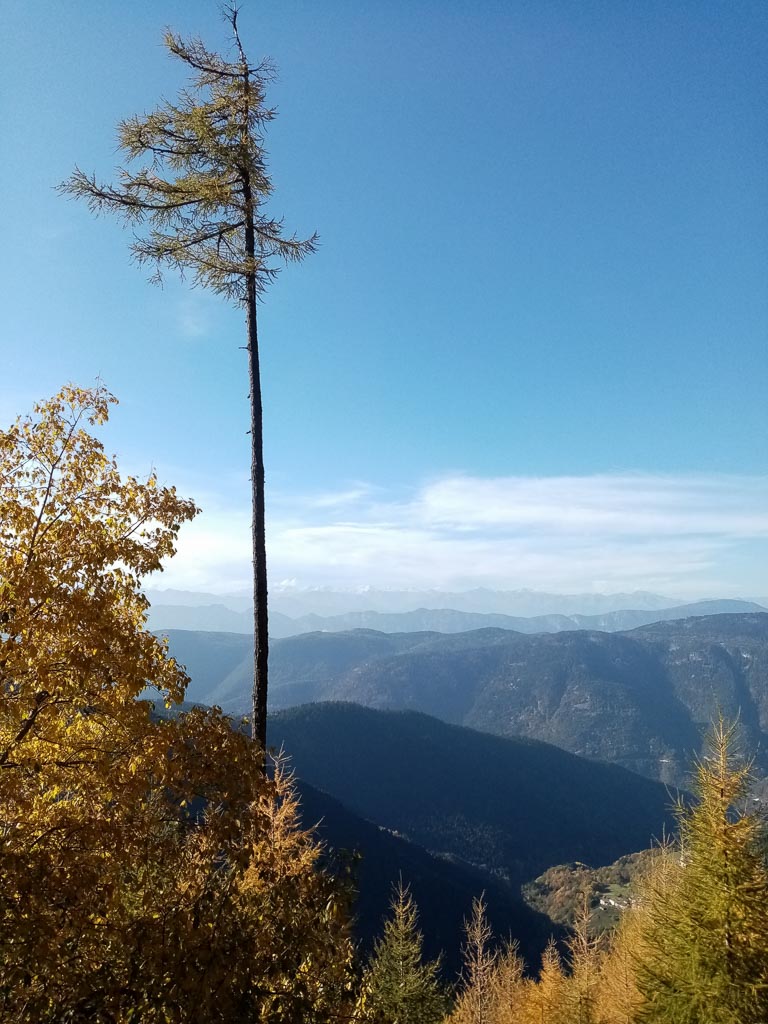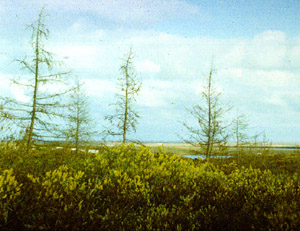Larix
Miller 1754
Common names
Larch [English], mélèze, mélèze laricin [French:]; lärche [German]; larice [Italian]; Лиственница listvenitsa [Russian]; カラマツ karamatsu [Japanese], 落叶松属 [Chinese].
Taxonomic notes
Syn: Pinus Linnaeus p.p.; Abies A. L. de Jussieu (non Miller) (Dallimore et al. 1967).
Larix is the type genus of Pinaceae subfamily Laricoideae, which also includes Cathaya and Pseudotsuga (Frankis 1989, Farjon 1990, Li 1993).
There are 11 species in this treatment:
There is also one naturally-occurring nothospecies, Larix × czekanowskii Szafer (1913), the hybrid of L. gmelinii and L. sibirica. It is discussed under L. sibirica.
Larix is sister to Pseudotsuga, a relationship established by morphology (Frankis 1989) and confirmed by molecular studies; however the time since the last common ancestor is very unclear, with Ran et al. (2018) placing it in the late Cretaceous while Qiu et al. (2024) place it in the mid-Eocene. The earliest Larix fossils are Eocene (Larix altoborealis in the Canadian arctic), but LePage and Basinger (1995) comment that they are clearly distinct from Pseudotsuga by that time, and that "the origin of the group is to be found most probably in the Cretaceous". Debate about correct circumscription of species has been ongoing for over 200 years, with the European and North American species and varieties are generally agreed upon, while there has been debate about the Asian taxa. Much of this involved L. sibirica and L. gmelinii, which together have a vast range including a small disjunct region (L. gmelinii var. principis-rupprechtii) and very extensive zones of hybridization with each other and with intraspecific varieties (Milyutin and Vishnevetskaia 1995). The other big puzzle has been sorting out the taxa associated with the Qinghai-Tibetan Plateau, and on this front new insights have come as recently as 2024. Here is a quick summary of the findings from molecular studies:
- Isozymes demonstrate clear differences between New World and Old World larches (Semerikov and Lascoux 1999).
- Nuclear ITS markers in seven species of Larix and five of Pseudotsuga confirm a North America-Eurasia division (Gernandt and Liston 1999, Wei and Wang 2004).
- Pollen cpDNA from 12 species of Larix identify three sister clades, one including North American species, and the other two comprised of the short-bracted and long-bracted species of Eurasia, except that L. sibirica is in the long-bracted clade (Wei and Wang 2003).
- Markers from the nuclear, chloroplast, and mitochondrial genomes of ten species demarcate North American, North Eurasian, and South Asian taxa, except that L. sibirica is grouped with South Asian species on the cpDNA tree, but with its North Eurasian congeners on the mtDNA tree (Gros-Louis et al. 2005).
- An even larger largest dataset with multiple specimens from each taxon confirms major clades in North America, northern Eurasia, and southern Asia (see cladogram at right). The northern clades (North America and northern Eurasia) are sisters. In North America, L. lyallii is sister to (L. laricina + L. occidentalis). In northern Eurasia, all taxa are clearly discrete but relationships are close: L. decidua sister to the Asian taxa, and the relationship between the varieties of L. gmelinii is confirmed. Relationships are biogeographically plausible if there was active gene flow between L. gmelinii and L. kaempferi during low sea level stands associated with Pleistocene glaciations, but L. decidua was effectively isolated from L. siberica by the extremely cold and dry climate of central Asia. Things are more complicated in the south Asian clade: eastern Himalayan species were first differentiated from more eastern taxa of the Hengduan mountains, and the Hengduan Mountains taxa then differentiated over a long period, from the Oligocene into the Pliocene. These results indicated that L. potaninii var. himalaica should be treated as a variety of L. griffithii, L. griffithii var. speciosa warrants treatment at species rank, and the relationship between L. mastersiana and L. potaninii should be inspected more closely (Qiu et al. 2024). A molecular clock indicates divergence between the northern and southern clades at about the Eocene/Oligocene boundary with rapid speciation in the southern clade during the rise of the Qinghai-Tibetan Plateau, while an Oligocene split between the northern Eurasian and North American clades may signal exclusion of the genus from arctic latitudes associated with Oligocene cooling.
Some papers also discuss "short-bracted" vs. "long-bracted" species; prior to molecular analyses the genus was commonly divided according to whether cone bracts are exserted or included. Molecular studies have largely supported this division, with south Asian taxa all long-bracted and north Eurasian taxa all short-bracted; the division is not taxonomically significant in North America, though.
Description
Deciduous trees with sparse, open crowns. Bark silver-gray to gray-brown on young trees, becoming reddish brown to brown, smooth initially, scaly to thickened and furrowed with age. Branches whorled; shoots strongly dimorphic; short (spur) shoots prominent on twigs 2 years or more old, each bearing leaves (needles), and often pollen cone, or seed cone; lateral long shoots (sylleptic branches) sometimes produced by current-year growth increments; leaf scars many. Buds rounded. Leaves in tufts of 10-60 on short (spur) shoots or borne singly on 1st-year long shoots, deciduous, ± flattened, with abaxial keel, sessile, base decurrent, sheath absent, apex pointed or rounded; resin canals 2. Pollen cones solitary, ovoid-cylindric, yellowish. Seed cones green, red or purple, maturing pale to dark brown in 4-7 months, persisting several years after seed release, erect, globose to ovoid, terminal on short shoots or lateral on 1-year-old long shoots, on a short leafy peduncle; scales persistent, circular to oblong-obovate, thin, tough and leathery, lacking apophysis and umbo; bracts included or exserted. Seeds winged; cotyledons 4-6. x=12" (Parker 1993, M.P. Frankis e-mail 1999.02.26).
Distribution and Ecology
The North American species are in the US and Canada: boreal in Alaska and Canada, and S to the northern Appalachian Mountains; and are also in the North Cascades and Northern Rockies in Washington, Oregon, Idaho, Montana, Alberta, and British Columbia. The northern Eurasian species are widespread in the Alps, the Carpathians, and most of boreal Russia, and S to Japan and NE China. The Qinghai-Tibetan Plateau species occur on the plateau including its margins, mostly in China (and Tibet), but also in Bhutan, India, and Nepal (Farjon 2010 and species accounts hereunder).
Remarkable Specimens
The largest and tallest specimens are found in Larix occidentalis, by a wide margin. The oldest are found in Larix lyallii; the second-oldest is Larix decidua.
Ethnobotany
Some species of Larix are economically important for their hard, heavy, and decay-resistant wood (Parker 1993). Top quality knot-free wood ('boatskin larch') is in great demand for yacht building (M.P. Frankis e-mail 1999.02.26). Despite their popularity as garden trees, only a few have received any horticultural attention; some cultivars exist for the most commonly cultivated Old World larches, L. decidua Miller and L. kaempferi (Lambert) Carrière, but almost none for the North American species (Parker 1993). L. kaempferi is a popular bonsai subject in Japan (M.P. Frankis e-mail 1999.02.26).
All species have been used in dendrochronology, principally for dendroclimatic reconstruction, although there has been recent use of the North American and European taxa in ecological and ecophysiological research.
Observations
See the species descriptions.
Remarks
Larix was the Roman name for larch (Parker 1993).
Larches are widely used in forestry in cool-temperate to subarctic zones. L. sibirica has proved the most successful tree for use in Greenland, but L. decidua and L. kaempferi have received the greatest international attention. Most if not all hybrid combinations attempted have been successfully created; the hybrid L. decidua × L. kaempferi (L. × marschlinsii Coaz, syn. L. × eurolepis Henry nom. illeg.) is an important forest tree in Britain.
Citations
Farjon, Aljos. 1990. Pinaceae: drawings and descriptions of the genera Abies, Cedrus, Pseudolarix, Keteleeria, Nothotsuga, Tsuga, Cathaya, Pseudotsuga, Larix and Picea. Königstein: Koeltz Scientific Books.
Frankis, M. P. 1989. Generic inter-relationships in Pinaceae. Notes Roy. Bot. Gard. Edinburgh 45: 527-548.
Gernandt, D. S. and A. Liston (1999). Internal transcribed spacer region evolution in Larix and Pseudotsgua (Pinaceae). American Journal of Botany 86: 711-723.
Gros-Louis, M.-C., J. Bousquet, L. E. Pâques and N.e Isabel. 2005. Species-diagnostic markers in Larix spp. based on RAPDs and nuclear, cpDNA, and mtDNA gene sequences, and their phylogenetic implications. Tree Genetics & Genomes 1(2): 50-63.
LePage, Ben A. and James F. Basinger. 1995. The evolutionary history of the genus Larix (Pinaceae). Pp. 19-29 in W. C. Schmidt and K. J. McDonald (compilers), Ecology and Management of Larix Forests: A Look Ahead. USDA Forest Service General Technical Report GTR-INT-319.
Miller, P. 1754. The Gardener's Dictionary, abridged edition 4, vol. 1.
Qiu, Xiu-Fei, Yan-Yan Liu, Ge Wu, Cong-Hui Xu, Xin-Quan Liu, Xiao-Yan Xiang, Xiao-Xin Wei, and Xiao-Quan Wang. 2024. Phylogenomic analyses shed new light on the spatiotemporal evolution of global larches: implications for the dynamics of boreal forests. Molecular Phylogenetics and Evolution 202:108240. doi.org/10.1016/j.ympev.2024.108240.
Ran, Jin-Hua, Ting-Ting Shen, Hui Wu, Xun Gong, and Xiao-Quan Wang. 2018. Phylogeny and evolutionary history of Pinaceae updated by transcriptomic analysis. Molecular Phylogenetics and Evolution 129:106–116. doi.org/10.1016/j.ympev.2018.08.011.
Semerikov, Vladimir L and Martin Lascoux. 1999. Genetic relationship among Eurasian and American Larix species based on allozymes. Heredity 83(1): 62-70. Available: www.nature.com/hdy/journal/v83/n1/full/6885310a.html, accessed 2007.10.22.
Szafer, W. 1913. Larix x czekanowskii hybr. nov. Kosmos 38:1281-1322 (p. 1297). Available: Śląska Biblioteka Cyfrowa (p. 458 of 870), accessed 2024.06.27.
Wei, X.-X. and Wang, X.-Q. 2003. Phylogenetic split of Larix: evidence from paternally inherited cpDNA trnT- trnF region. Plant Systematics and Evolution 239(1-2): 67-77.
Wei, X.-X. and Wang, X.-Q. 2004. Recolonization and radiation in Larix (Pinaceae): evidence from nuclear ribosomal DNA paralogues. Molecular Ecology 13(10): 3115-3123.
See also
Bobrov 1972), an early monographic treatment of Larix.
Gower, Stith T., and James H. Richards. 1990. Larches: deciduous conifers in an evergreen world. BioScience 40:818-826.
Ostenfeld and Syrach Larsen (1930), an early monographic treatment of Larix.
Schmidt-Vogt, H. 1977. Die Fichte; Ein Handbuch in zwei Banden. Band I: Taxonomie, Verbreitung, Morphologie, Ökologie, Waldgesellschaften. Hamburg - Berlin.





